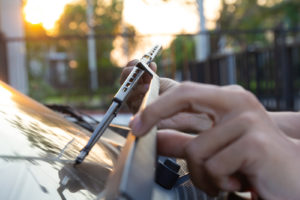5 Reasons Why Your Windshield Wipers Stopped Working
September 25th, 2020 by Fix Auto USA

If you’ve noticed your windshield wipers stopped working, driving in inclement weather can become frustrating and even dangerous. The wiper arms and blades move in sync, clearing the windshield of rain, snow, or debris that might obstruct your view. When they fail, it becomes harder to see and prevent road accidents.
We’ll guide you through why windshield wipers stop working, what you should check first, and when to seek professional help from a reliable auto repair service like Fix Auto USA.
1. Torn or Worn-Out Wiper Blades
The most common reason for windshield wipers not working is worn or torn blades. Typically, rubber blades become brittle or cracked from sun, rain, and snow exposure after six months. The damage prevents them from clearing water or debris properly, leaving streaks and impairing your visibility.
What to Look For:
- Streaking or uneven wiping across the windshield
- Squeaking noises when wipers are in use.
- Visibly damaged rubber edges
What to Do: Inspect your blades every six months. If they’re damaged, replace them immediately. Most wiper blades are easy to swap out and available at auto parts stores. Remember that wiping the blades thoroughly with a damp towel every few weeks can prevent grime and residue buildup, extending their lifespan.
2. Faulty Wiper Motor
Your wipers are powered by a motor under the windshield cowl or in the engine bay. If both windshield wipers stopped working suddenly, the motor might have burnt out or short-circuited.
Symptoms of a Faulty Wiper:
- No movement from the wipers at all when turned on
- A faint clicking noise when you switch on the wipers
- The motor feels warm to the touch, indicating overheating
What to Do: Inspect the motor for visible damage or loose wiring connections. If you’re unsure or the motor seems beyond repair, get a professional assessment.
3. Blown Wiper Fuse
A burnt-out fuse can stop the wipers from functioning. This issue is often the result of an overloaded wiper motor or electrical surge. Fuses protect the motor, so if yours blows, it’s doing its job by preventing further damage.
How to Check the Fuse:
- Locate your car’s fuse box (usually found under the dashboard or hood).
- Identify the wiper fuse using the diagram on the fuse box cover.
- Inspect the fuse for a broken filament or scorch marks.
What to Do: Replace the blown fuse with one that matches the amperage rating. If the new fuse blows soon after, have a professional inspect the motor and wiring to diagnose deeper issues.
4. Extreme Inclement Weather
Most windshield wipers aren’t designed with enough torque to clear away heavy snow and ice buildup. For instance, using them during a blizzard could cause the wiper arm and blades to become warped, misaligned, or stuck.
What to Do If Wipers Stop Working While Driving:
- Pull over safely to the side of the road.
- Clear snow and ice from the windshield manually using a snow brush or ice scraper.
- Avoid using wipers to remove ice or heavy snow in the future to prevent damage.
Prevent Wiper Damage: In winter, lift your wipers away from the windshield when parked to prevent them from freezing to the glass. You can also invest in winter-specific wiper blades that handle snow and ice more efficiently.
5. Loose or Damaged Wiper Pivot Nuts
Pivot nuts connect the wiper arm to the transmission. If these nuts become loose, your motor may function, but the wiper arms won’t move properly. You could end up with a broken windshield wiper, or both may stop working.
Signs of Loose Pivot Nuts:
- One wiper moves while the other stays still
- Wipers that start moving but stop mid-cycle
Quick Fix: Tighten the pivot nuts with a wrench or ratchet. Securely fasten, but don’t overtighten them, as this could cause further damage.
How to Choose the Right Windshield Wiper
If your wipers have run their course, you’ll need to get new ones. At first glance, wiper blades might all seem the same—black, slender, and mostly metallic. But with a closer look, you’ll see they come in different designs that affect their installation, performance, and durability.
Standard rubber blades are reliable for typical weather and are affordable for most drivers. However, if you face frequent heavy rain or snow, upgrading to winter blades or silicone blades is a better choice. Winter blades have a protective casing to prevent snow and ice from clogging the blade mechanism, while silicone blades offer longer durability and superior performance in extreme temperatures.
Always check your car’s manual for the right size—an incorrect fit can result in the windshield wipers not working properly. Investing in high-quality blades suited to your driving conditions can prevent a broken windshield wiper and keep your visibility clear and safe.
Fix Auto USA Offers Reliable Windshield Wiper Repair and Replacement
If you’ve tried troubleshooting but your windshield wipers stopped working despite your efforts, the professionals at Fix Auto USA can help. We’ll inspect and repair your vehicle’s electrical system for issues that could affect the wiper motor. Need to replace a fuse, tighten a pivot nut, or install a new, upgraded pair of wipers? Our technicians will handle it.
Contact us today to schedule service at a Fix Auto USA location near you!
This blog post was contributed by Fix Auto Kearny Mesa, a leading industry expert and collision repair shop servicing Kearny Mesa and surrounding areas in San Diego.
Welcome to
Fix Auto USA
We are the premier independent body shop network delivering world-class customer service and high-quality collision repairs across the U.S.
Learn About Us





